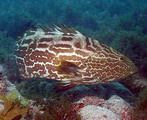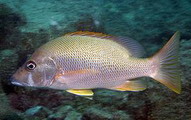 海洋生物學家在巴西海岸延伸到大西洋之外的大陸架間發現了新的珊瑚礁群,他們相信這個新發現比巴西面積最大、生態最豐富的珊瑚礁系統—Abrolhos還要大兩倍。
海洋生物學家在巴西海岸延伸到大西洋之外的大陸架間發現了新的珊瑚礁群,他們相信這個新發現比巴西面積最大、生態最豐富的珊瑚礁系統—Abrolhos還要大兩倍。
這個新發現區域比所知的Abrolhos珊瑚礁系統的海洋生態還要更為豐富,而Abrolhos的部份已被巴西政府保護,Abrolhos珊瑚礁系統是世界上最獨特及重要的珊瑚礁區域之一。
來自Espirito Santo大學和Bahia大學保育國際協會的研究者7月8日以書面在美國羅德岱堡所舉行的國際珊瑚礁座談會中宣布他們的發現結果。
「我們從當地漁民的口中知道還有其他的珊瑚礁存在,但是不知道規模是如此之大。」該報告的撰寫人之一的摩拉 (Rodrigo de Moura),同時也是保育國際協會巴西的海洋生物學家表示。
位於Bahia州海灘70公里外的Abrolhos列島是海洋國家公園,其被保護的部分是已被科學家知道的淺層珊瑚礁群。
Abrolhos被認為是世界上最重要的珊瑚礁之一,因為其中棲息了大量只在巴西發現的海洋物種,包含僅在Abrolhos發現的軟珊瑚、軟體動物和魚類。
Mussismilia珊瑚是一種近似遠古珊瑚的遺留物種,在大西洋其他地方都已經絕種,但是卻是Abrolhos珊瑚礁最為普遍的珊瑚,外觀看起來像是蘑菇一般的形體。
7個來自3個不同機構的研究員使用一艘具備側邊掃瞄的聲納儀器,可以提供3D的海床繪圖。他們繪出了Caravelos城海岸外海新的珊瑚礁結構,長達離岸邊15到200公里的距離,深至20至73公尺。
「因為這些新發現的珊瑚礁相對地難以靠近,所以他們之中充滿著各種生物,在某些地區棲息的海洋生物種類比已知的淺珊瑚群要多上30倍之多。」保育國際協會巴西海洋計畫主管的杜特拉(Guilherme Dutra)表示。
「這是好消息的部分,壞消息就是僅有少數在Abrolhos棲息的海洋生物是受到保護的,儘管地方性和全球性的威脅與日遽增。」
地方性的威脅包含過度捕撈、海岸發展和大規模土地改為農耕地、養蝦場、污染、石油開發和沉積作用。全球性的威脅包含氣候變遷和海水酸化的問題。
 研究員自2000年便一直在監測Abrolhos的情況,因為他們發現了之前沒有在這個淺珊瑚礁群出現的某些大型魚類和珊瑚種。杜特拉說:「我們現在正在執行這個研究的下一階段,Sao Paolo大學也是我們的合作伙伴,我們將會使用由他們遠端控制的車輛來進行研究,這個研究顯示出Abrolhos區域珊瑚礁的複雜性和連結程度,並會提供支持保育計畫的資料。」
研究員自2000年便一直在監測Abrolhos的情況,因為他們發現了之前沒有在這個淺珊瑚礁群出現的某些大型魚類和珊瑚種。杜特拉說:「我們現在正在執行這個研究的下一階段,Sao Paolo大學也是我們的合作伙伴,我們將會使用由他們遠端控制的車輛來進行研究,這個研究顯示出Abrolhos區域珊瑚礁的複雜性和連結程度,並會提供支持保育計畫的資料。」
這個研究是保育國際組織所控管的海洋管理區域科學計畫的一部份,有來自世界各地研究機構的參與,由Gordon and Betty Moore基金會和個別贊助人所贊助。
現在這個發現已經被公開宣佈了,杜特拉說保育國際組織和其科學家們的新發現,會促使巴西政府將保護傘延伸到新發現的珊瑚礁群上。
保育人士會和環保署的官員們一起推動保護措施,但是杜特拉說是否能成功其實仰賴他們是不是能喚起整個政府對這個新發現珊瑚礁的重視了。
Off the Brazilian coast, where the narrow continental shelf widens far out into the Atlantic Ocean, marine scientists have discovered reefs that they believe double the size of Brazil's largest and richest reef system, the Abrolhos Bank.
The newly discovered area is far more abundant in marine life than the previously known Abrolhos reef system, which is partially protected by the government of Brazil as one of the world's most unique and important reefs.
The researchers from Conservation International, the University of Espirito Santo and the University of Bahia announced their discovery in a paper presented Tuesday at the International Coral Reef Symposium now underway in Fort Lauderdale.
"We had some clues from local fishermen that other reefs existed, but not at the scale of what we discovered," said Rodrigo de Moura, Conservation International Brazil marine specialist and co-author of the paper.
Located about 70 kilometers from the coast of Bahia state, the Archipelago of Abrolhos is a marine national park, which protects part of the shallow reefs already known to science.
The Abrolhos Bank is considered one of the world's most important reefs because it is inhabited by a high number of marine species found only in Brazil, including species of soft corals, mollusks and fish found only on the Abrolhos shelf.
The Mussismilia coral genus, a relic group remnant of an ancient corals that went extinct long ago elsewhere in the Atlantic, is the dominant coral of the Abrolhos reef, which is structured in unique mushroom-like shapes.
Seven researchers from the three institutions used a boat with side-scan sonar equipment, which produces a three-dimensional map of the seabed.
They mapped the new reef structures in areas ranging from 15 to 200 kilometers (nine to 124 miles) offshore of the coastal city of Caravelos and in depths ranging from 20 to 73 meters (60 to 220 feet).
"Due to their relative inaccessibility and depth, the newly discovered reefs are teeming with life, in some places harboring 30 times the density of marine life than the known, shallower reefs," says Guilherme Dutra, Conservation International's director of marine programs in Brazil.
"That's the good news," he said. "The bad news is that only a small percentage of marine habitats in the Abrolhos are protected, despite mounting localized and global threats."
Localized threats include overfishing, coastal development and large scale land conversion to agriculture, shrimp farms, pollution, oil drilling and sedimentation.
Global threats include climate change and ocean acidification.
The researchers had been monitoring the shallow reefs of the Abrolhos Bank since 2000, when they started to find some large fish and pieces of coral that were not part of the shallow reef ecosystem they had been observing.
"We are doing another phase of the research right now with a remotely operated vehicle in which the University of Sao Paolo is also a partner," Dutra said. "These studies reveal the complexity and connectivity of the reefs in the Abrolhos region and will support conservation planning," said Dutra.
The studies are part of the Marine Management Area Science Program coordinated by Conservation International with the participation of research institutions around the world, and supported by the Gordon and Betty Moore Foundation and individual donors.
Now that the discovery has been announced, Dutra says Conservation International and fellow scientists will try to get the government of Brazil to extend protection to the newly found reefs.
The conservationists will work with officials at the Environment Ministry to achieve protection, but Dutra says success depends upon their ability to call the attention of the government as a whole to the importance of the newly discovered reefs.
全文及圖片詳見:ENS





